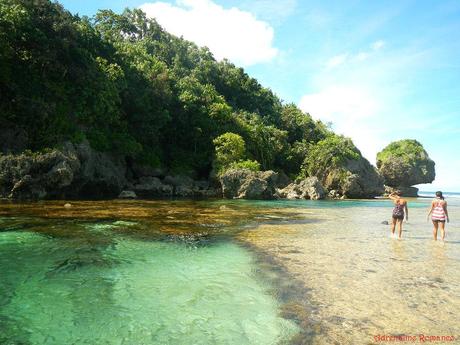
In the realm of adventuring, you sometimes need the help of Sister Luck so that you can witness Mother Nature’s amazing spectacles. Think about it: mountaineers only have a limited window to reach the summit and witness the incredible vista around them. Rock climbers ascend crags only in good weather to ensure the climb is fun and safe. Scuba divers have to be in a specific spot in a specific time in a specific dive spot to witness sardine runs, gatherings of rare sharks, cleaning stations, and more.
The alluring Magpupungko tide pools in Pilar, Siargao are among those wonders in which you need a little bit of luck so you can witness its full splendor. Specifically, these stunning pools only show up during low tide.
We didn’t stay long in Guyam Island because we still had a one-hour cruise to reach our next destination in Pilar, which is north of Siargao Island. Now, our destination can be reached via land trip, but it would take more than two hours to reach there. By boat, however, it would take just an hour.

Earlier during our ride, we noticed our boatman Roel laying down a rope line. Suddenly, he made the boat’s engine run idle and excitedly pulled the line. It turned out that he caught a large, swift fish. Look at that monster!

As we neared our destination, Roel stopped the boat’s engine in the middle of the sea, got into waist deep water, and slowly pushed the boat. It turned out that we came across a submerged sandbar which made the water too shallow for the boat to pass through without risking damage to the propeller. I got down and helped him push the boat until we got to the edge of the sandbar.

As our destination loomed closer, we spotted these two gigantic rock outcroppings with one rock tower seemingly leaning to the bigger islet. If the water is sufficiently deep and there are no sharp rocks below, then this leaning tower is perfect for deep water soloing (i.e., a form of rock climbing that relies on the presence of deep water at the base of the crag to protect the climber against injury from falls. No ropes or safety equipment are used in DWS).

At last, after an hour riding the waves of the Pacific, we arrived at our next destination at Magpupungko beach.

From the looks of the place, it seemed to be just like the many beautiful beaches we’ve visited in our travels—beaches characterized by fine sand, swaying palms, and few people.

After paying a small entrance free, we followed a path behind the beach and into our last destination for the day. It turned out to be one of the most unique natural wonders we have ever seen.

When we emerged between two rock outcroppings that formed an arch, we saw the pride of Pilar, the gigantic and magnificent Magpupungko tide pools. Aside from a few tourists, we were pretty much alone in this beautiful place.

Check that out! It’s like Mother Nature’s very own swimming pool! As its name implies, a tide pool is a depression or cavity on the seashore which is filled with seawater.
Tide pools are hardly discernible during high tide. But when the tide recedes, seawater becomes trapped in these cavities forming these characteristic pools.

Check out our humble video of the place. The Magpupungko tide pools are truly wonders of nature.
Tide pools vary in depth. Here, Sweetie stood at the very edge of a deep end of a tidal pool. The area at the bottom of the photo below, however, is quite shallow.

It’s a pretty amazing feeling when strolling along the edge of a tide pool. Just think, we were walking on shin-deep water on an expansive mudflat. But just beside us are green, ethereal pools that are several meters deep! Vast, vast contrast, isn’t it?
Oh, and check out that rock formation ahead of us. We’ll get to that shortly.

Some sections of the tide pool appear to be part of the surrounding mudflats. But actually, these seemingly solid sections are large patches of kelp and brown algae. They form an important part of the fragile ecosystem in a tide pool.
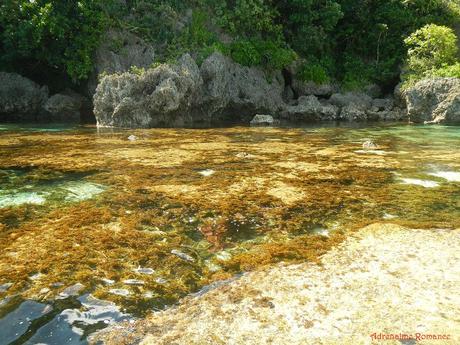
How in the world did that mammoth rock get up—or down—there? It’s precariously yet perfectly balanced! Simply amazing!
The place is named Magpupungko because of this rock’s position, which seems as if it is squatting on a larger one. Pungko is Visayan for “to squat,” so after adding some prefixes, the name became Magpupungko.

Beyond the Magpupungko rock formation, we arrived at shallow, sandy pools, which we thought were conducive to non-swimmers. In fact, we were wondering why there weren’t any people here considering the lovely sandy bottom.
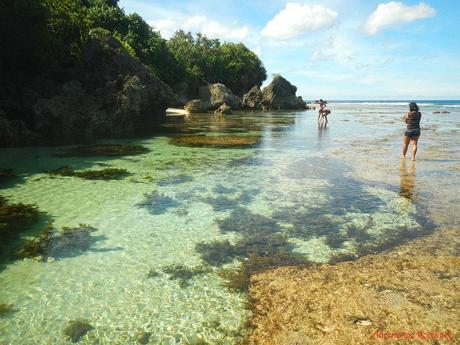
Well, it turned out that these tide pools are habitats of reef snakes and sea kraits such as this one! Sea snakes have some of the most powerful venom in the world. In fact, in some species, the venom is more potent than that of a cobra’s.
Fortunately, sea snakes are often shy and reluctant to bite. In fact, there are only very few human fatalities reported. Nevertheless, sea snakes should be treated with deep respect and caution.

Is that a vast pine forest and water as its sky? A part of an alien world perhaps? No, it’s just the picturesque seascape under a shallow tide pool.

Incredible, isn’t it? See how vast and enchanting these tidal pools are? They beat any man-made swimming pool by a mile!

Opposite of the tidal pools, the powerful waves of Siargao smash on the shores of the mudflat. They’re pretty big, but these are simply just appetizers. The biggest waves will arrive in September and October.
As each mighty wave ends its life on the mudflat, sheets of seawater flow into the pools, replenishing their water supply.

You might think we’re riding an airplane high above a snowy landscape in the Alps. They’re actually kelps growing on submerged rocks. As you probably have already guessed, tide pools are homes to a huge variety of organisms.

Satisfied with the photos we took, we went back to the pool nearest to the beach and enjoyed a refreshing swim there. As you can see, there are plenty of corals, flora, and fauna to see even in shallow water.

Protected from strong currents and other hazards of the open sea, these tidal pools are perfect for snorkelers!
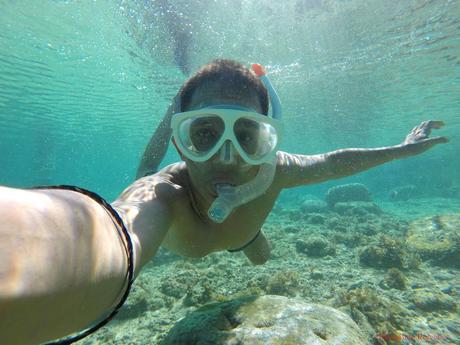
Stout elephant ear corals grow at the sides of rock outcroppings. They provide shelter for many marine organisms that inhabit the pool.

We did tell you earlier that some sections of the tidal pools are deep, right? Well, just to give you an idea of how deep, check out the photo below. That’s Jessica swimming towards a good-sized outcropping that conveniently acts like a diving platform.
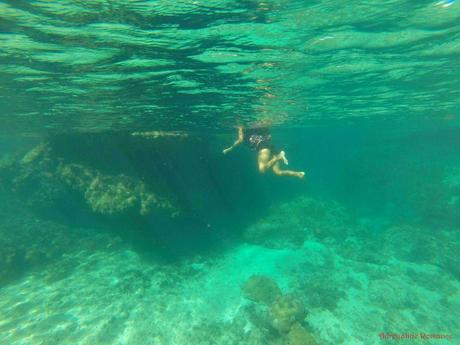
We told you so it was a diving platform. Hehehe! Many sections of the pools are safe to dive from because they’re deep enough and the edge of the tidal flat is just a few strokes away. In other words, as long as you can swim, there’s very little chance of drowning.

Tide pools are homes to some of the hardiest marine organisms on Earth. Despite their serene appearance, tidal pools are hostile places for many sea creatures. Inhabitants of tidal flats must be able to adapt to a constantly changing environment, particularly continuous fluctuations in oxygen content, salinity, and temperature of water as the tide comes rolling in and out every day.
Such organisms should also be able to withstand hazards such as strong waves, exposure to the sun, and inadequate protection from predators.

After an hour of snorkeling, diving, and just enjoying Mother Nature’s infinity pool, it was time to go back to Siargao before the tide becomes too low and leave our boat stranded in the mudflat.
Goodbye, Magpupungko! We will miss you, and thank you for letting us enjoy your playground.

As we went back to deep open water (we had to go to deep water to avoid shallow reefs and rock beds), the waves became bigger and more powerful. We had a silent scare when the boat’s engine sputtered and coughed several times. Oh, no! Are we going to get stranded out here in the ocean?
Well, it turned out that Roel simply slowed down at times in the hopes of catching another fish. Hehehehe!

On the way home, we passed by this rock island. Now, focus on the middle of the photo below. Notice the pier? Well, we actually thought it was a man-made pier. However, Roel said that the structure is completely natural even though it seemed to be cleanly cleaved by an earth-moving machine!

This razor-sharp, spiky, and oddly shaped coral rock islet is the result of constant erosion by the relentless power of the sea and wind.

Here’s another rock islet off the coast of Siargao. Roel and the girls said that this is actually a surfing area for those who want to ride bigger waves. Unlike in Cloud 9, you need to be able to swim here since the sea surrounding the island is pretty deep.

At around 4:30 PM, we finally arrived at a beach beside Cloud 9. Thank you very much, Roel, for the exciting, magical, and safe ride. Thank you very much, Jessica and Nenette, for making this island hopping adventure even more fun!

Mother Nature must have been really kind to us because the next day turned out gray and drizzly. If you remember what we mentioned a few posts earlier, we weren’t able to follow our original itinerary because of the bad weather. We were pretty lucky; two rainy days sandwiched our perfectly sunny, island hopping day!
We rode one of those habal-habals with a roof (in case it rains) straight to Sayak Airport in Del Carmen.

Pretty soon, it was time to leave Siargao. As with all our trips, Sweetie and I felt a certain kind of sadness, knowing that another chapter of our never-ending journey as travelers and adventurers has come and gone. But we also felt a sense of happiness and relief as Mother Nature replenished our spirits with renewed energy and tranquility.

Tips to Follow

